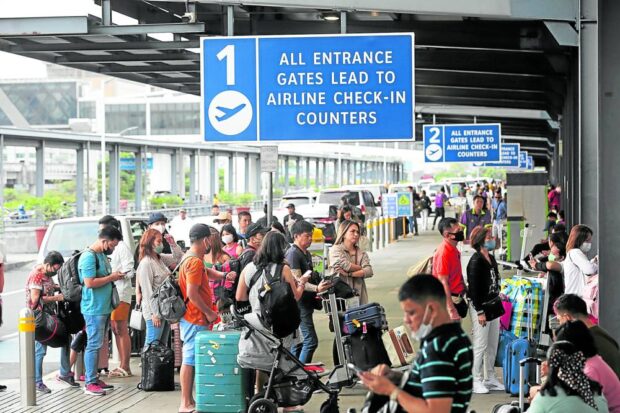
NORMALIZING Passengers line up at the departure area of Ninoy Aquino International Airport as travel demand returns.—INQUIRER FILE PHOTO
Passenger movement at the country’s main gateway continues to regain lost ground, inching closer to prepandemic levels, as it accommodated more domestic and international flights in the first half, according to the Manila International Airport Authority (MIAA).
In a recent statement, the management of the Ninoy Aquino International Airport (Naia) said that international and domestic passengers soared by 78 percent to 22.22 million in January to June. This figure is only 8 percent lower compared to the number of passengers registered in the same period in 2019.
The flight movements, meanwhile, were up 42 percent to 135,883 for the period, which was at the same level that the Naia handled in the first half of 2019.
“We are pleased to experience these surges in statistics—a strong indication that passengers have regained the confidence to travel again,” MIAA officer-in-charge Bryan Co said.
“The double-digit surge in our flight movements and passenger volume is enough ground for optimism that the aviation industry is steadily heading towards full recovery,” he added.
Air travel demand
The increase in both passenger and flight movements were complemented by the ramping up of domestic and international networks by the local airlines.
Among the restarted routes were the flights to China, which is a popular tourist destination in the continent. This country is expected to drive air travel demand in Asia in 2023.
“Comforted with the consistent growth in numbers, with airlines introducing new routes, and with new airline players coming in, we will pursue without let-up our improvement projects, especially those that would highly impact the passenger experience inside and outside of the terminals,” Co said.
According to aircraft leasing company Avolon, the Philippines and the rest of Asia are expected to register the fastest growth in terms of passenger origin in the next two decades—even outpacing Europe—on the back of a recovering economy and accelerating cross-border mobility. This means more airline passengers are projected to come from the Philippines and other Asian countries.
Despite the positive outlook, the lack of available aircraft is threatening the growth of the aviation sector.
Philippine Airlines and Cebu Pacific recently had to cancel or suspend several flights as some of their aircraft were grounded for maintenance. US-based engine manufacturer Pratt & Whitney is unable to provide required aircraft maintenance immediately due to supply chain issues. The local carriers are now augmenting their fleet and reducing flights to mitigate the situation.
Recently, MIAA completed its terminal reassignment initiative to optimize the capacity of the four terminals. All international flights are in Naia terminals 1 and 3 while the other two cater to domestic operations. INQ